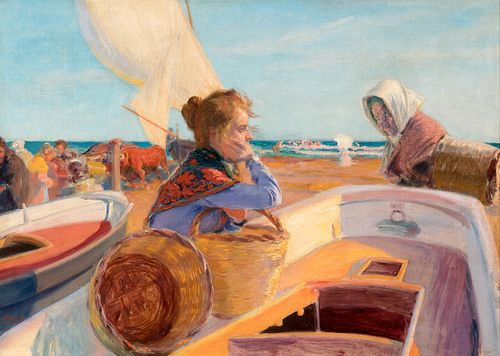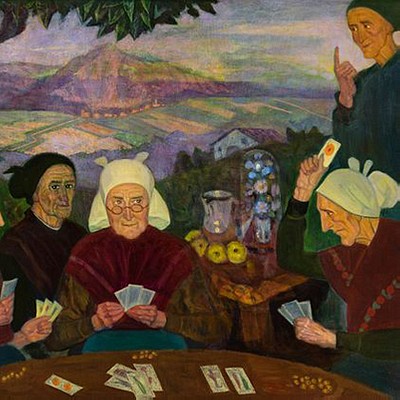JOSÉ MONGRELL TORRENT (Valencia, 1870 - Barcelona, 1937). "Marina". Oil on canvas.
Lot 98
About Seller
Setdart Auction House
Carrer Aragó 346
Barcelona
Spain
Setdart Subastas was born in 2004 and is currently the first online art auction in Spain with solidity, prestige and reliability guaranteed by our more than 60,000 users. Setdart has a young, dynamic and enterprising team ready to successfully manage the purchase and sale of art works through custom...Read more
Categories
Estimate:
EUR€50,000 - EUR€60,000
$52,083.33 - $62,500
Absentee vs Live bid
Two ways to bid:
- Leave a max absentee bid and the platform will bid on your behalf up to your maximum bid during the live auction.
- Bid live during the auction and your bids will be submitted real-time to the auctioneer.
Bid Increments
| Price | Bid Increment |
|---|---|
| EUR€0 | EUR€10 |
| EUR€200 | EUR€25 |
| EUR€500 | EUR€50 |
| EUR€1,000 | EUR€100 |
| EUR€3,000 | EUR€200 |
| EUR€5,000 | EUR€500 |
| EUR€10,000 | EUR€1,000 |
| EUR€20,000 | EUR€2,000 |
| EUR€50,000 | EUR€5,000 |
About Auction
By Setdart Auction House
Dec 14, 2021
Set Reminder
2021-12-14 08:00:00
2021-12-14 08:00:00
America/New_York
Bidsquare
Bidsquare : 19th & 20th Century Fine Art
https://www.bidsquare.com/auctions/setdart-auction-house/19th-20th-century-fine-art-7992
Gaudi, Sorolla, Torres Garcia, Maclet, TSUGUHARU FOUJITA, Benjamin Palencia Setdart Auction House sofia@setdart.com
Gaudi, Sorolla, Torres Garcia, Maclet, TSUGUHARU FOUJITA, Benjamin Palencia Setdart Auction House sofia@setdart.com
- Lot Description
JOSÉ MONGRELL TORRENT (Valencia, 1870 - Barcelona, 1937). "Marina". Oil on canvas. Signed on the left side. Measurements: 50 x 70 cm; 81,5 x 102 cm (frame). The influence of his mentor Joaquín Sorolla can be appreciated in this magnificent painting by José Mongrell, but what is striking is a way of resolving the composition in which he himself was a master: with audacity, Mongrell has superimposed different levels of reality, from the fishermen's wives who await in the foreground the return of their husbands, to the bathers in the background, passing through the lady of high society who enjoys a pleasant summer day. The framing is almost photographic, as it cuts out the boat on which the young woman is leaning with her basket, waiting to fill it with fish. To the left, the oxen can be glimpsed, ready to load the boats that will dock at the coast. Multiple scenes are interwoven in the painting, being worked with different levels of chromatic and light definition, in a reliable atmospheric rendering of the different planes. Valencian luminism reaches here the highest levels. José Mongrell studied at the San Carlos School of Fine Arts in Valencia, where he was a disciple of Ignacio Pinazo and Joaquín Sorolla. He was gaining artistic renown thanks to his participation in numerous competitions and exhibitions in Madrid and Barcelona. In 1897 he made, with great success, the bullfighting poster for the San Jaime Fair in Valencia, and in fact his poster for the July Fair in Valencia in 1912 was reedited in 1971 on the occasion of the centenary of these festivities. He obtained a teaching post at the San Jorge School of Fine Arts in Barcelona, where he lived for the rest of his life. From this period, the work he did for the Palace of the Generalitat de Cataluña, in charge of the Diputación de Barcelona, stands out, as well as his portrait of King Alfonso XIII. He also made mosaics in the modernist style, such as those of the great arch of the Mercado de Colón and the façade of the Estación del Norte, both in Barcelona. Mongrell was dedicated to genre genre, portraiture and landscape, and was a master of capturing the moment, making his scenes acquire vitality and dynamism, through bright and naturalistic colors and lights. Traditionally pigeonholed as a disciple of Sorolla, Mongrell only learned from the master that which served to extend his art. The painter developed his work somewhere between regionalism and modernism, but a certain French-influenced symbolism can also be appreciated in his work. In fact, Mongrell was characterized by emphasizing the content, attributing to the image a meaning that goes beyond pure appearance. At a time when great historical, idealistic and dramatic compositions triumphed, this painter developed a style of painting concerned with capturing the past and the present from an everyday, friendly and picturesque perspective, generally far removed from the grandiloquence and theatricality of academic history painting. Despite his technical mastery, Mongrell did not fall like others into a refined mannerism at the service of an unimportant theme, but developed a fully personal language, characterized by its dynamism and expressive freedom. Currently, José Mongrell is represented in the Museo de Bellas Artes San Pío V and the Museo Nacional de Cerámica y de Artes Suntuarias González Martí of Valencia, the Museo de Bellas Artes of Asturias, Badajoz and Pontevedra, the Museo Nacional de Arte de Cataluña, the Rijksmuseum of Amsterdam, the Museo de La Habana and the Museo de Bellas Artes of Buenos Aires, among others.
- Shipping Info
-
In-house shipping available. Please inquire at admin@setdart.com.
-
- Buyer's Premium



 EUR
EUR CAD
CAD AUD
AUD GBP
GBP MXN
MXN HKD
HKD CNY
CNY MYR
MYR SEK
SEK SGD
SGD CHF
CHF THB
THB

















